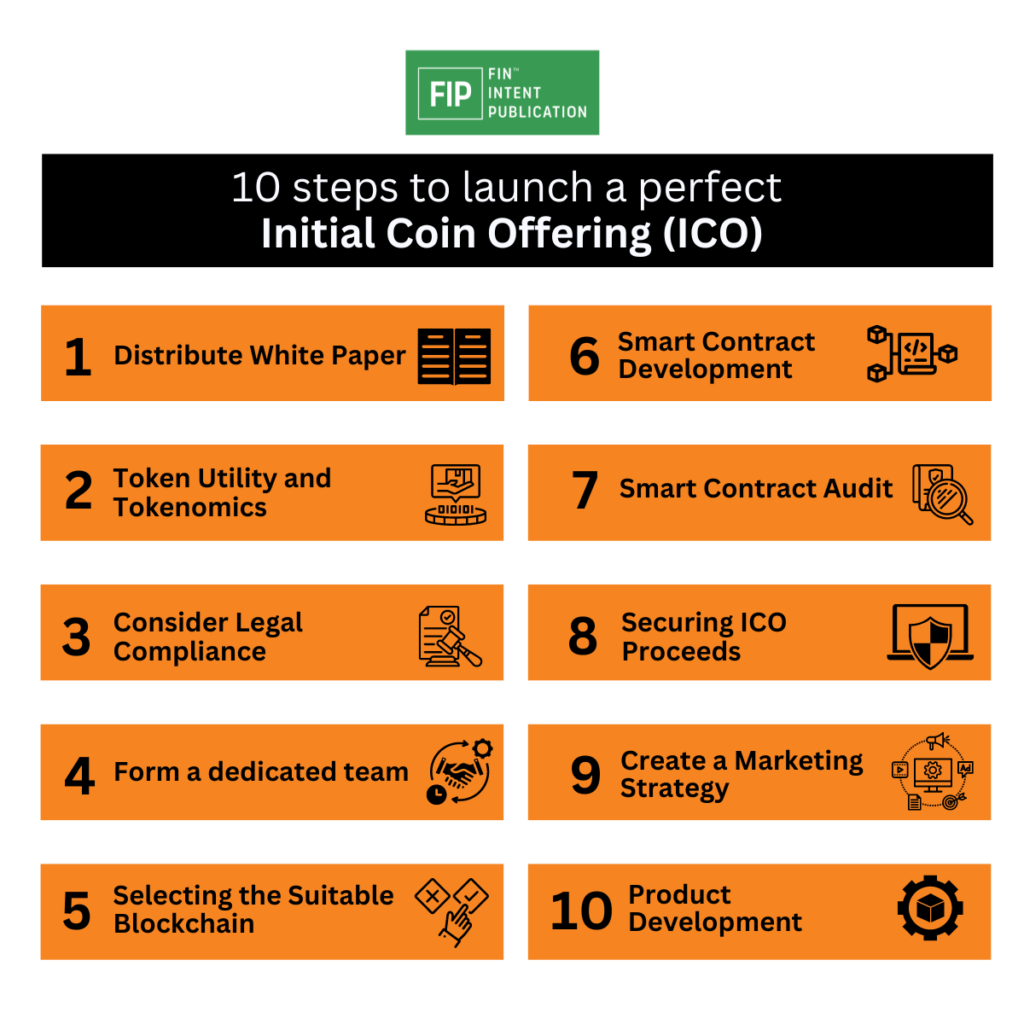In this comprehensive guide to Initial Coin Offerings (ICO), we delve into the intricacies of this innovative fundraising mechanism. From understanding how ICOs work to evaluating their potential risks and rewards, embark on a journey through the evolution, impact, and challenges faced by Initial Coin Offerings. Join us as we explore the past, present, and future of this transformative financial landscape.
What is an ICO?
An initial coin offering (ICO) serves as the crypto realm’s counterpart to a traditional initial public offering (IPO). When a company aims to generate funds for a new coin, app, or service, it launches an ICO as a fundraising avenue.
Potential investors can engage in an ICO by purchasing tokens newly issued by the company. These tokens might offer utility linked to the company’s product or service, or they could represent a share in the company or project.
Takeaways:
- ICOs are a prevalent means of funding for cryptocurrency-related products and services.
- Unlike IPOs, ICO coins may carry functional use within software services or products.
- While some ICOs have been lucrative for investors, others have faced issues such as fraudulence or poor performance.
- Participating in an ICO typically requires acquiring established digital currency and familiarity with cryptocurrency wallets and exchanges.
- Given their largely unregulated nature, ICO investments demand extensive research and caution from investors.

Types of Initial Coin Offerings ICO
There are two primary types of initial coin offerings:
1. Private ICO
Private ICOs have restricted participation, usually limited to accredited investors—financial institutions and high net-worth individuals. Companies conducting private ICOs might set minimum investment thresholds.
2. Public ICOs
Public Initial Coin Offering (ICO) functions as a form of crowdfunding open to the general public. This inclusive investment approach allows almost anyone to participate. However, due to regulatory considerations, private ICOs are gaining traction compared to public offerings.
According to Wikipedia, In 2017, ICOs and token sales surged in popularity, with at least 18 websites dedicated to tracking ICOs by mid-year. A notable instance was the ICO for Brave, a new web browser, which amassed about $35 million in less than half a minute in May. Similarly, Kik’s ICO in September of that year raised close to $100 million.
By October 2017, ICOs had raked in $2.3 billion, a staggering leap from the previous year’s total—more than tenfold growth. The momentum continued, averaging around 50 offerings each month by November 2017. Notably, Filecoin’s ICO in January 2018 set a record, raising $257 million, with $200 million collected within the initial hour of their token sale.
10 steps: How to launch an Initial Coin Offering (ICO)
As you make up your mind to know more, let’s delve into the essential 10 steps required to create an ICO.
1: Distribute White Paper
A white paper serves as the foundational document detailing the technical intricacies and rationale behind your project. It elucidates the purpose behind your product, the problems it aims to address, and the methodology proposed for their resolution. Specifically, it outlines the utility inherent in your cryptocurrency token.
Consider the Bitcoin whitepaper released in 2008 by the pseudonymous Satoshi Nakamoto. Nakamoto meticulously articulated the creation of a peer-to-peer electronic cash system, addressing potential issues like double spending and presenting technical solutions involving timestamp servers and proof-of-work systems.
Likewise, a comprehensive white paper is paramount for founders. It undergoes scrutiny from potential investors and contributors. As a pivotal technical and marketing artefact, a compelling white paper is instrumental in the success of your ICO.
2: Token Utility and Tokenomics
Investors seek clarity regarding the utility of your token to assess its investment potential. Absent utility, a token risks becoming merely a speculative asset.
Tokens function as mediums of exchange within platforms, native tokens facilitating gas fee payments, or even granting voting rights within decentralized applications. Additionally, investors extensively examine tokenomics, encompassing factors like scarcity akin to Bitcoin or inflationary attributes akin to Cosmos’ ATOM. Allocation percentages, vesting periods for stakeholders, and other details significantly influence token market pricing.
3: Consider Legal Compliance
Undoubtedly crucial, legal compliance is a foundational aspect that cannot be overlooked. Ignoring legal compliance may attract regulatory repercussions, potentially derailing your project.
Founders embarking on an ICO must prioritize compliance with varying regulations across jurisdictions. Depending on the country of launch, registration with securities regulators, adherence to anti-money laundering (AML) and know-your-customer (KYC) regulations, and understanding of evolving cryptocurrency taxation norms are imperative. Seeking guidance from legal and financial experts is paramount to mitigate legal risks and foster investor trust.”
4: Form a dedicated team
Building a proficient team stands as a cornerstone for any project’s success. Execution, often the most challenging aspect, necessitates a capable team to transform vision into reality.
For your blockchain endeavour, assembling a team encompassing blockchain and software engineers, UI/UX designers, content creators, sales and marketing experts, and adept advisors is pivotal. Incentivizing team members via ICO proceeds and token allocations further aligns their interests with project success.
5: Selecting the Suitable Blockchain
Among the plethora of blockchains available, choosing the right one that aligns with your project’s ethos is crucial. Ethereum, renowned as a leading smart contract platform, notably facilitated ICO launches initially. However, its popularity has led to network congestion, resulting in sluggish transactions and elevated gas fees.
To address concerns regarding high fees, Ethereum’s layer-two (L2) solutions like Optimism or Base offer viable alternatives. These L2s leverage Ethereum’s security while mitigating high gas fees, gaining traction over time.
Alternative blockchains such as BNB Chain and Polygon have gained prominence. Notably, BNB Chain, integrated with Binance—the world’s largest crypto exchange—hosts ICOs via Binance Launchpad, catering to crypto investors.
6: Smart Contract Development
Cryptocurrencies on platforms like Ethereum and BNB Chain operate through smart contracts, necessitating their development for an ICO launch. The ERC-20 token standard, prevalent on Ethereum, facilitates token creation.
For teams equipped with engineering expertise, creating a smart contract is achievable. Alternatively, no-code solutions like ThirdWeb offer simplified cryptocurrency creation for resource-limited ventures. Code libraries like OpenZeppelin provide pre-tested and community-reviewed code for streamlined smart contract creation.
7: Smart Contract Audit
Conducting a thorough audit is imperative to unveil potential vulnerabilities and errors in your smart contract code. Especially crucial for ICO-related smart contracts—dealing with investor funds demands utmost caution to ensure their safety and avoid legal repercussions.
Audits not only fortify the ICO process against technical glitches but also bolster investor trust. Engaging professional auditing firms or offering bug bounties for public review are prudent steps to bolster security.
8: Securing ICO Proceeds
When configuring your ICO’s smart contract, designating a wallet address to receive proceeds is fundamental. Opting for hardware wallets, offering top-tier security is recommended. Implementing multi-signature hardware wallets, especially for larger teams, adds an extra layer of protection.
Diversifying ICO proceeds across multiple wallet addresses within the smart contract minimizes risk in the event of a compromise. In the crypto realm, security should never be an afterthought—prioritize protection measures to safeguard investor funds.
9: Create a Marketing Strategy
An effective marketing strategy can determine the success or failure of your ICO. Even the most promising project can falter if potential investors remain unaware of its existence.
Establishing a well-branded website serves as the cornerstone of effective marketing. It serves as the project’s face and, potentially, the ICO’s minting platform.
Elevating brand visibility through social media, engaging video content, and informative blogs is indispensable in today’s landscape. Quality content demands investment to stand out; hiring skilled content creators, community managers, and copywriters can amplify your outreach.
Platforms like Twitter and Discord resonate strongly within the crypto community. Budget allocation for ads and collaboration with influencers can significantly expand your reach.
10: Product Development
An alternative approach to ICO marketing involves creating a product that garners substantial interest. Ethereum’s Arbitrum layer-two rollup serves as a prime example.
Arbitrum focused on developing an Ethereum scaling solution that attracted user attention and anticipation. Its achievements spoke for themselves, eliminating the need for extensive marketing efforts as its prowess drew eager investors.
Conclusion
Initial Coin Offerings (ICOs) have reshaped fundraising in the digital era, offering an innovative avenue for funding projects and services within the cryptocurrency realm. They’ve democratized investment opportunities, inviting both success stories and cautionary tales.
The diversity between public and private ICOs underscores the evolution of this fundraising method, highlighting inclusivity versus exclusivity in investor participation. The surge in ICO popularity, evident through explosive fundraising figures and milestones, reflects both the immense potential and inherent risks associated with this financial mechanism.
As ICOs continue to evolve, their unregulated nature necessitates thorough research and vigilance from investors. The ICO landscape represents a transformative but challenging domain, underscoring the need for prudence and continuous scrutiny amid its ongoing growth.





